Consistent data sets help lighting designers make more accurate predictions.
Pat Goodman, Sudhir Subramanya and Steve Landau, Philips Lumileds
The marketing hype touting LEDs as having a useful lifetime of more than 100,000 h simply is not true. It is possible that an LED may function after 100,000 h, but it may not provide useful or usable light for that duration, and the application or fixture will have long ceased to function effectively.
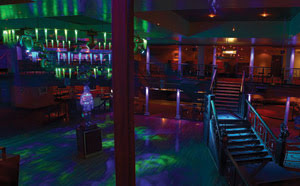
Although there are many factors that determine how much light an LED can produce, when trying to understand the lifetime and reliability of an LED, two primary factors must be considered by the lighting engineer: first, how hot the LED chip gets during operation and, second, the drive current applied to the LED. These two factors are within the control of the design engineer and form the basis of how an LED will perform over time.
As adoption of LEDs in general lighting increases, designers are asking manufacturers to adopt the lighting community’s language and definitions and to leave behind the world of semiconductors. Reliability is one of the areas in which a common language can be adopted. The lighting industry historically has evaluated the reliability of light sources to better understand minimum illumination and relamping intervals. This has been defined as the time by which a certain percentage of the population of LEDs is expected to have failed (Figure 1).
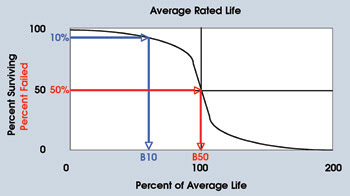
Figure 1. The standard industry expression for failure rates of lighting devices is shown.
Note that it is important to understand the definition of a failure. For an incandescent bulb, a failure is the catastrophic flash experienced when the filament fuses open. But it is unusual for LEDs to have a catastrophic failure. More commonly, one will see slight lumen depreciation with time (Figure 2). When this depreciation meets a certain threshold, such as more than 30 percent, the LED is considered not to meet specification.
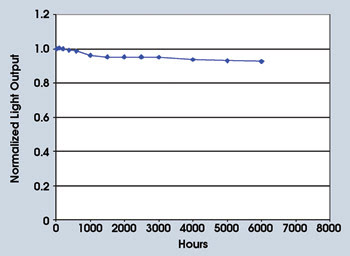
Figure. 2. This graph shows how the light output of a Luxeon White K2 LED from Philips Lumileds declines over time. When extrapolated to 10,000 h at maximum operating conditions, the depreciation is 9.8 percent. The output is normalized to 1 at 24 h.
The figure of 30 percent was chosen as an example because the Alliance for Solid-State Illumination Systems and Technologies (ASSIST) found that the human eye can tell that the lighting level has changed when an LED is at 70 percent lumen maintenance (L70); however, the alliance’s research also shows that most people find a 30 percent reduction in light output acceptable for general lighting applications. (Although this could be considered a standard of acceptance, ASSIST recommends that figures should vary depending on the application.) The LED still may produce 69.99 percent of the original flux, but it does not meet the specification of less than 30 percent lumen depreciation and will be counted as a failure.
Lumen maintenance
Many factors come into play when designing lighting systems to maintain a uniform illumination. Maintaining constant current is one. Choosing the right current for proper illumination is important, but it also is critical for lumen maintenance to find a low forward current that will extend the LED’s lifetime as well as a high enough current for proper illumination.
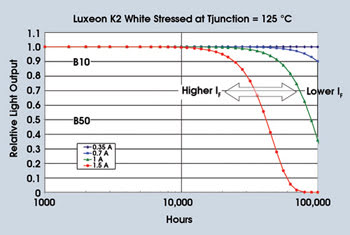
Figure 3. Changes in forward current affect the useful lifetime of an LED. As the current is reduced (the red line progressing to the blue line), the lifetimes increase (If= forward current).
Likewise, the temperature of the LED junction also influences lumen maintenance. Lighting designers who are not familiar with semiconductors must understand the relationship between the junction temperature (used above) and the temperature of the heat sink (case temperature). The conversion between an external reference or case temperature and the junction temperature is strongly dependent on the overall system design; therefore, case temperature and junction temperature are included in data sheets with certain assumptions. More commonly, the data sheet will cite an example of a thermal system and will provide the results showing that system. The generalized method is to sum the thermal resistances between the junction and the point of measurement (the heat sink or case).
Changes in forward current affect the useful lifetime of an LED. For example, as the forward current is reduced, the device lifetime is increased (Figure 3). Reductions in junction temperature also affect the useful lifetime of an LED in a similar manner (Figure 4).
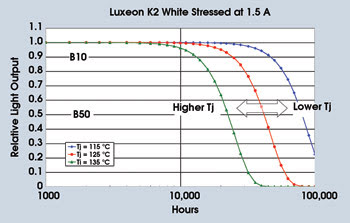
Figure 4. Reductions in junction temperature (Tj) (the green line to the blue line) affect the useful lifetime of an LED. As maximum temperature is reduced, the lifetimes increase, following a trend similar to that seen with forward current.
To enable a simplified graphical approach, more information is required than can be expressed by a simple lumen maintenance statement (L70). An equivalent to the traditional B-lifetime figure is necessary so that designers will know the percentage by which the lumen output has fallen below the agreed threshold. This B-figure will help designers specify LEDs that meet design requirements for a given system. For example, a B10 value for any given lamp denotes the time by which 10 percent of the population is expected not to meet specifications. Also used is the B50 value — the point where the failure to meet specification is 50 percent (sometimes called the rated or average life).
Philips Lumileds has proposed that LED lifetime testing data be expressed in terms of L-lifetimes as well as B-lifetimes. The statistics can be presented graphically with reference to driving current and junction temperature (Figure 5).
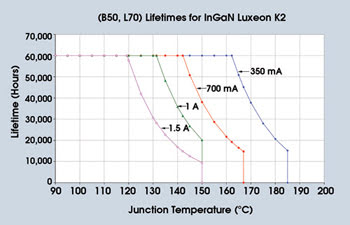
Figure 5. This graph for the Luxeon K2 LED family shows lifetimes for four values of continuous forward current (B50, L70 across current and temperature variables) up to the maximum rated value, with reference to a range of junction temperatures.
Using such graphical information, designers seeking a B50 solution to a lighting requirement can gauge the forward current and junction temperature for the desired lifetime. The driving circuit parameters and heat sink size also can be determined from this data. Beyond that, they can determine the number of LED sources required, the power supply rating, the thermal management requirements and cooling arrangements.
Using B/L data
Based on the quantity of data now available to Philips Lumileds, lumen maintenance can be forecast accurately to 60,000 h. LED manufacturers have varying amounts of data available to them, and results from one manufacturer’s LED cannot be attributed to another manufacturer’s product. Nonetheless, by continually adding to a given product’s database of actual lifetime data, it will be possible in the future to present extremely reliable forecasts for power LED lumen maintenance.
Industry groups such as ASSIST are providing data that is compatible with current design practice. However, LED vendors must go a step further and provide more detailed information about product lifetimes under various operating conditions. This would enable lighting designers to deliver the best combination of purchase price, lighting performance and cost of ownership for the life of the product.
Likewise, consumers should expect this data as a matter of course, in any combination of B, L, Tj (reduction in junction temperature) and If values, with clear definitions of failures. Only with these combinations of data can designers optimize their applications for performance and cost of installation and useful lifetime.
Meet the authors
Pat Goodman is senior applications engineer, Sudhir Subramanya is director of product marketing, and Steve Landau is director of marketing communications at Philips Lumileds in San Jose, Calif.; e-mail: [email protected].